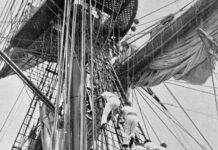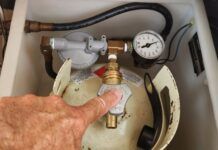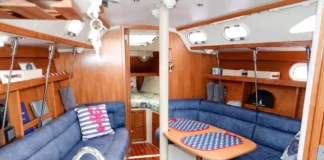This is the time of year when sailors in the frozen north plan their winter projects and think of next summer, with perhaps one eye on a warm-weather winter charter to see them through. This is the time of year when southern sailors—or those lucky enough to head south with the birds for the winter—cast a pitying eye on their northern cousins.
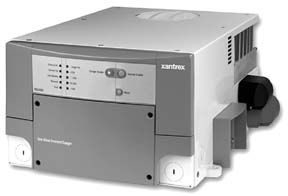
For all of us, this is the time of year for boat shows and marine trade shows. We recently visited two of the late fall shows—IBEX (the International Boatbuilders’ Exhibition and Conference), and the Fort Lauderdale International Boat Show, and came away with an eyeful of new products, updated older products, and new ideas. Here are just a few of them.
———-
More Power to You
We are generally pretty wary about reporting on products that have yet to hit the market, but two new families of electrical equipment from Xantrex are scheduled for release over the next few months, and they are products that will be of great interest to sailors.
Xantrex Technology is best known in the marine industry as the producer of the PROSine, Prowatt, Trace, and Heart Interface lines of inverters, chargers, and inverter/chargers. Most of these products carry their original manufacturers’ brand names, but all are marketed by Xantrex.
If anything, the company has too many lines of inverters and inverter/chargers. Choosing the right product from this broad family is not always simple. Do you want pure sine wave or modified sine wave? Line frequency or high-frequency switching technology?
MS2000 Inverter/Charger: Xantrex will be upping the ante over the next few months with the MS series of inverter/chargers. These will be true sine wave inverters, and they will eventually replace the Heart Interface Freedom series of inverter/chargers that really started the marine inverter explosion more than a decade ago.
The first in the series is the MS2000. This is a direct replacement for the venerable Freedom 20 inverter/charger, which may well be the most popular inverter charger for sailboats, powerboats, and recreational vehicles. With 2,000 watts of continuous output, and a surge capacity of 5,000 watts, this inverter will meet the needs of most sailboats. It will easily run microwave ovens, any 110-volt power tool you are likely to have on board, a vacuum cleaner, 110-volt refrigeration, and all the entertainment gear you can shoe-horn into your boat, including a big plasma screen and home theater surround sound. (And you thought you went sailing to get away from that stuff!)
The Freedom series of inverters features modified sine wave output. This stepped waveform is adequate for most 110-volt equipment, but may not be the best choice for more sensitive electronics such as high-end entertainment systems, some televisions, microwaves, and computers.
With the addition of more and more AC-powered gear on boats of all sizes, it makes little sense to stick with MSW technology when pure sine wave inverters are steadily decreasing in cost. It’s sort of like buying a black and white television when all programming is in color: it may still do the job, but why bother?
The new MS2000 has an integrated 100-amp multi-stage battery charger, as well as an automatic transfer switch that senses whether or not shore power is available, and brings the inverter online or offline to provide seamless AC power.
The charger has built-in echo charge to allow for simultaneous charging of primary and secondary battery banks without the need for external isolation. The 10-amp output of the echo charger will be adequate to keep a starting battery up to snuff, while the main charger is big enough for a large 12-volt house bank. Automatic power sharing reduces charger output during periods of high shorepower demand to prevent tripping the ship’s input breaker.
The MS2000 also has an on-board diagnostics panel, and the software can be upgraded in the field. You should be able to retrofit future improvements in operating software without sending the unit back to the manufacturer—a big plus.
A major feature of the MS2000 is its networking capability. Using the new NMEA 2000 communications protocol, the MS2000 can utilize a common communications bus to provide multiple control stations. For larger boats, the network can also incorporate an automatic generator starting function.
Say, for example, you have been running a quiet ship at anchor, with all AC loads carried by the inverter. The automatic generator start will crank the generator if the ship’s battery banks start to get low, bringing the battery charger online. When the batteries reach a user-defined state of charge, the generator will automatically shut down, returning you to a quiet ship.
Like the Freedom series, the MS inverter/chargers are designed for easy owner installation.
The one drawback of the MS2000 is its bulk. At about 8″ x 14″ x 16″, it’s a slightly larger package than the Freedom 20 it will replace, and at 68 pounds, it is some 18 pounds heavier.
The price has yet to be announced.
Xantrex Battery Charger: Unless you need a new battery charger right now, it might be worth waiting for the new Xantrex battery chargers, scheduled for release in late spring or early summer, 2004. For international cruisers, the new chargers are designed to run off any voltage from 90 to 265, supplied at either 50Hz or 60Hz.
Each charger will have three independent outputs with individual control. You can program the charger for different battery chemistries for each output. Each output will provide the voltage and charge rate suited for the individual battery.
This means that your hard-working house bank can be getting its bulk charge at 14.2 volts, while the rarely used starting battery can be simultaneously receiving a low-amperage maintenance float charge at 13.2 volts.
Each battery can have its own temperature sensor to insure proper temperature compensation while charging. Temperature compensation is critical to proper charging, particularly at high charge rates.
The charger’s digital display and control panel can be oriented for vertical or horizontal mounting of the charger, or can be removed completely and mounted remotely.
Both 12- and 24-volt models will be available, with outputs of 30 or 50 amps at 12 volts, 15 or 25 at 24 volts.
These chargers will supplement rather than replace the existing Truecharge series from Xantrex. There has been no price announcement, but you can expect them to be somewhat more expensive than the Truecharge units, thanks to the additional features of the new charger.
Xantrex, 604/422-8595, www.xantrex.com
———-
A Versatile Replacement Portlight, and Better Wash-Down Fittings
New Found Metals is a niche manufacturer of marine hardware. Their particular niche is replacement portlights in stainless steel and bronze, but they also have a limited line of high-quality deck hardware such as cleats and handrails.

Company founder Richard Walcome was one of the marine industry pioneers in utilizing manufacturing facilities in mainland China. With 25 years of experience, he has honed the Asian connection to a fine art that shows in the excellent finish and details of the company’s products.
While bronze and stainless ports are the company’s bread and butter, New Found Metals has just released a composite plastic and stainless replacement port that is both easy to install and good-looking. These would make excellent replacements for your tired plastic ports.
Trimatrix ports have a molded ABS trim ring and flange, and utilize type 316 stainless steel load-distributing plates to prevent distortion of the frame when installing. The ports are suitable for installation in cabinsides from 3/8″ to 1-3/8″ without modification. By adding a factory-made solid teak spacer, you can fit the ports to cabin sides as thin as 1/8″.
Thanks to a nifty fastening system, no conventional nuts and bolts are used, resulting in an extremely clean look. Hinges and dogs are fully adjustable for a tight seal over time.
Perhaps best of all, the ports come with a pre-installed compressible bedding strip, so no additional bedding or caulking is required. This makes for quick installation with no cleanup.
Because these are bolt-together ports (as are all ports in the New Found Metals line), each size of port can be used in openings that vary significantly in size. The 5″ x 12″ port, for example, can be fitted in cutouts that vary from 5-1/2″ x 12- 1/2″ to 7-1/2″ x 15-1/2″ without modification.
The retail price of the 5″ x 12″ port is about $167. The 7″ x 15″ port sells for about $216.
Although it’s not new, the company’s deck washdown fitting, now distributed through ITT Jabsco, deserves mention. It’s a compact, flush fitting with a type 316 stainless body. A simple adapator, screwed onto the end of your deck hose, locks into the fitting and turns on the water. It can be attached and detached under full water pressure.
It may be a simple, elegant fitting, but it literally took years to perfect, and it is by far the best deck washdown connection we have ever seen, with virtually no above-deck projection to snag toes or sheets.
New Found Metals,360/385-3315, www.newfoundmetals.com
———-
Compact Coastal Survival
Installing safety equipment on a small boat poses a conundrum. For example, where do you fit a liferaft that would be suitable for use on a 40-footer into the far smaller space you find on a 32-footer? For coastal cruisers on a small boat—say, a couple, or a couple with two small children—the Switlik Rescue Pod 4 can offer a level of safety and protection far greater than that afforded by PFDs, but in a compact package that is cheaper than many coastal liferafts.
The big advantages of Switlik’s Rescue Pod 4 are its small size and light weight. The four-person, valise-packed Rescue Pod 4 weighs just 33 pounds, and fits into a soft valise with a volume of just over 2,700 cubic inches—the size of a large backpack. Adding the optional inflatable floor increases this volume somewhat.
By way of comparison, the Groupe Zodiac four-person valise-packed coastal liferaft manufactured for West Marine weighs 63 pounds and has a stowed volume of over 5,000 cubic inches, occupying almost twice as much space as the Rescue Pod 4.
This is, to some extent, an apples-to-oranges comparison. The Rescue Pod is not recognized as a lifesaving device by any national authority. The Zodiac coastal liferaft meets the current US Sailing liferaft requirements for offshore racing through Category One, including such races as the Newport/Bermuda Race. (Rafts purchased after January 1, 2004 may be required to meet higher standards for offshore racing.)
The Rescue Pod 4 would be a good solution as an emergency craft for near-shore cruising on a small boat lacking storage space for a conventional liferaft. It has single-tube buoyancy, an inflatable insulated canopy, and safety features such as ballast pockets, inner and outer lifelines, a sea anchor, and an automatically activated exterior locator light. Standard equipment includes puncture repair clamps, a manual inflation pump, and a waterproof strobe/flashlight. This keeps the weight down, but it means that you should provide a range of survival equipment yourself—flares, water, first-aid kit, waterproof VHF radio—in a floating abandon-ship bag such as the ACR RapidDitch Express.
(Note that none of the buoyant emergency gear bags on the market actually specifies the amount of inherent buoyancy. Remember that a “floating” ditch bag that is overloaded to the point it sinks like a stone is pretty useless.)
With 12 square feet of interior floor space, the Rescue Pod 4 would be a tight fit for four adults. For two adults, plus two smaller children, it would offer acceptable short-term accommodations.
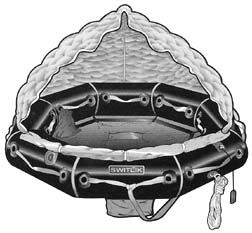
Like any inflatable device, the Rescue Pod must be periodically inspected, including checking the integrity of the buoyancy tube, the canopy, and the automatic inflation mechanism and cylinder. Because there is no stowed safety gear to replace at specified intervals, inspection cost should be reasonable when compared to that for a liferaft.
We don’t think the Rescue Pod 4 should be seen as a substitute for a coastal liferaft, even though they share many of the same characteristics, and even look pretty much the same at first glance. Switlik is careful to point this out in their literature.
The Rescue Pod 4 bridges the gap between personal floatation devices and an approved liferaft, both in cost and function. When equipped with the inflatable floor, it offers the hypothermia protection associated with a liferaft. Hypothermia, rather than exposure to severe weather, is perhaps the greatest danger in most abandon-ship scenarios.
The cost of the Rescue Pod 4 is just over $1,700. Adding the separate inflatable floor, which we highly recommend, brings the price to just about $2,000.
For a full review of the Rescue Pod 8—this pod’s larger sibling, see “Liferafts Revisited” in Practical Sailor’s January 15, 2003 issue.
Switlik Parachute Company, 609/587-3300, www.switlik.com
———-
Hold It There
The PYI Floor Anchor is a beautifully machined quick-release panel fastener, designed specifically as a hold-down system for floorboards. Most boats have loose floorboards that simply rest on beams or other supports. If a boat is knocked down or rolled over, these floorboards can become dangerous missiles, as can anything stowed beneath them.
For offshore racing, the ISAF (International Sailing Federation) Special Regulations, commonly know as the Special Regs, require that all heavy items of equipment be securely fastened to the boat while racing. The management for most offshore races includes floorboards as equipment that must be fastened. A system that holds floorboards securely in place, yet allows easy access to spaces below, has been one of the perpetual design and construction challenges for boatbuilders and owners.
The PYI floor anchor is the perfect solution to this problem. It will hold down floorboards securely, yet can be easily and quickly released using either a coin or a flat-blade screwdriver.
There are two components to the floor anchor. The machined and threaded receiver is threaded into the underlying support structure. The quick-release stud is mounted in the floorboard itself. A quarter turn of the stud engages or releases the locking mechanism, which is similar to the bayonet base of some low-voltage light bulbs.
When the floor is locked down, all you see on the surface is a neat, flush grommet and the release/locking slot.
All components are machined from type 316 stainless steel. A special installation kit allows drilling for both the stud and receiver in one go, greatly speeding up installation. Two different floor anchor lengths are available, so that floor thicknesses from 1/2″ to 1-1/4″ can be accommodated without modification.
These US-made floor anchors are not cheap. A single anchor retails for $17 or $18, depending on the length. The installation kit, with its custom bit, costs $45. Production will probably move overseas to lower the price, as production costs here (the fitting requires a lot of precision machining) are almost prohibitively expensive.
PYI, 425/355-3669, www.pyiinc.com
———-
There are more innovative products where these came from.
Next month we’ll discuss some new “black box” technology from Nobeltec, the upgraded Little Wonder Watermaker, and some excellent alternatives in paper chart back-ups from Bellingham Chart Printers.




































